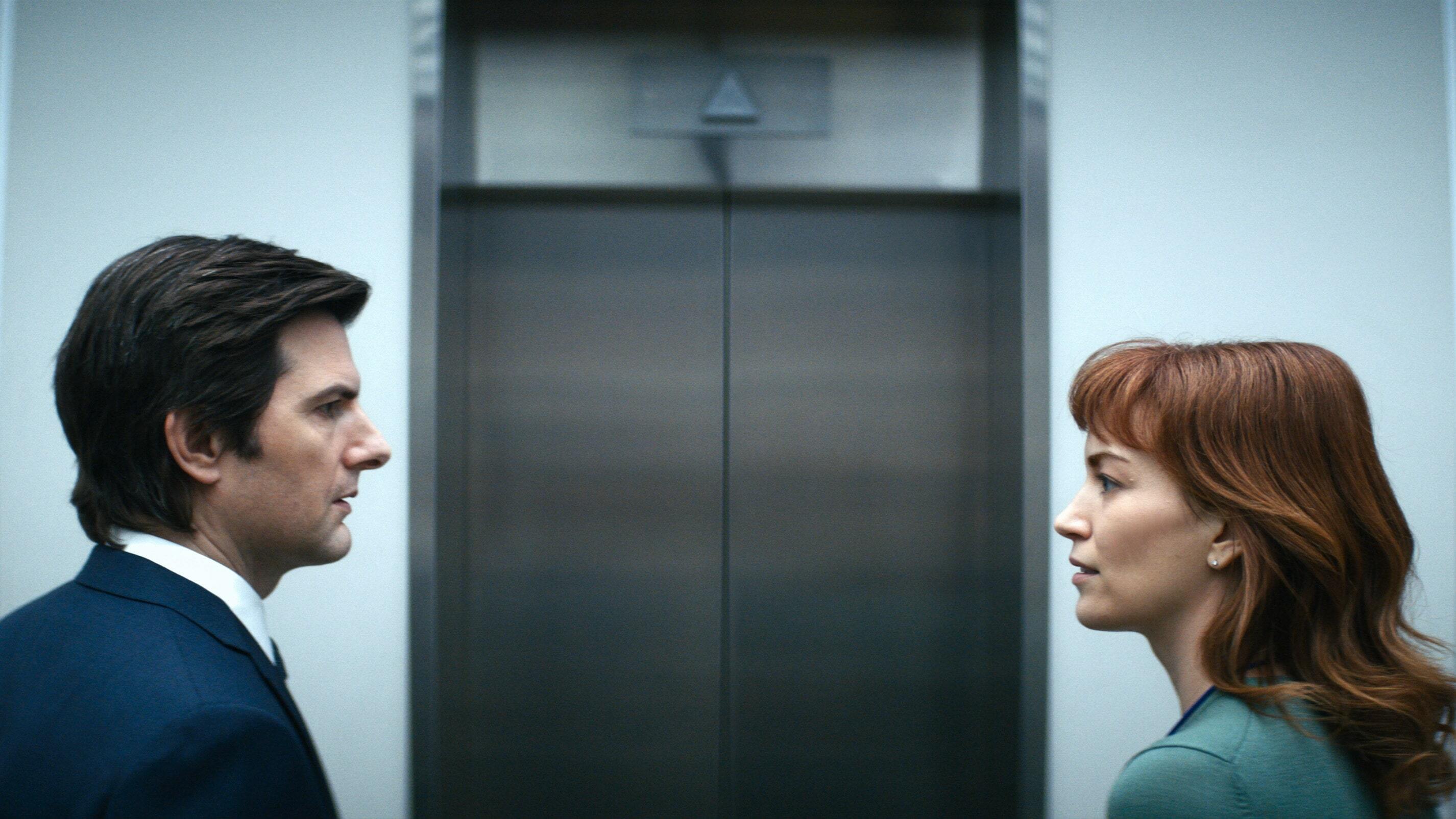
When Jessica Lee Gagné first read the premise of Severance she was terrified.
She wasn’t scared of the Innie world, the Break Room, Lumon’s mysterious board, the Waffle Party, or the countless other creepy unknowns that Apple TV+’s mysterious workplace thriller introduces in its first season. Well, maybe she was. But as a cinematographer, her main fear was that shooting in a plain white office with no windows or outside light would be too creatively limiting.
After some convincing from director Ben Stiller, who she’d worked with before, and pre-production inspirations including Lars Tunbjörk’s “Office” and Lee Friedlander’s “At Work” photo books, Gagné saw the show’s vast aesthetic potential. Rather than shooting Lumon’s offices traditionally, she experimented with lighting, color, camera movement, framing, and lenses to create Severance‘s distinct cinematic look and help set the series’ cryptic, eerie tone.
Mashable spoke with Gagné about her masterful eye, collaborating with Severance‘s cast and crew, and how she helped bring one of the most visually stunning shows in television history to the screen. The following interview has been edited for length and clarity.

Credit: APPLE TV+
Mashable: Being the sole cinematographer for a nine-episode season is an extraordinary feat normally, but it’s especially huge because Severance is one of the most visually stunning shows I’ve ever seen. For those who aren’t aware, what exactly are cinematographers responsible for on set?
Jessica Lee Gagné: Ah. That’s a big question. As a cinematographer one of my goals is to bring to life visually what the director sees. Depending on the director you work with the goal changes — there are different partnerships out there. Ben and I have worked together — on Escape at Dannemora — before, and it was a long project. It was a seven-episode show, and I did all of that as well. So we were in a really comfortable space where we knew each other and had created a language already. Severance was just a continuation of that creative bond. Ben really brings out the best in his creative partners by giving them a lot of space. And I think that Severance was teamwork. So as a DP [director of photography] you see yourself as one of the big parts of creating the world. But on a show like Severance, you really have to work with the production designer, props, everyone. It was a big team effort to get it through.
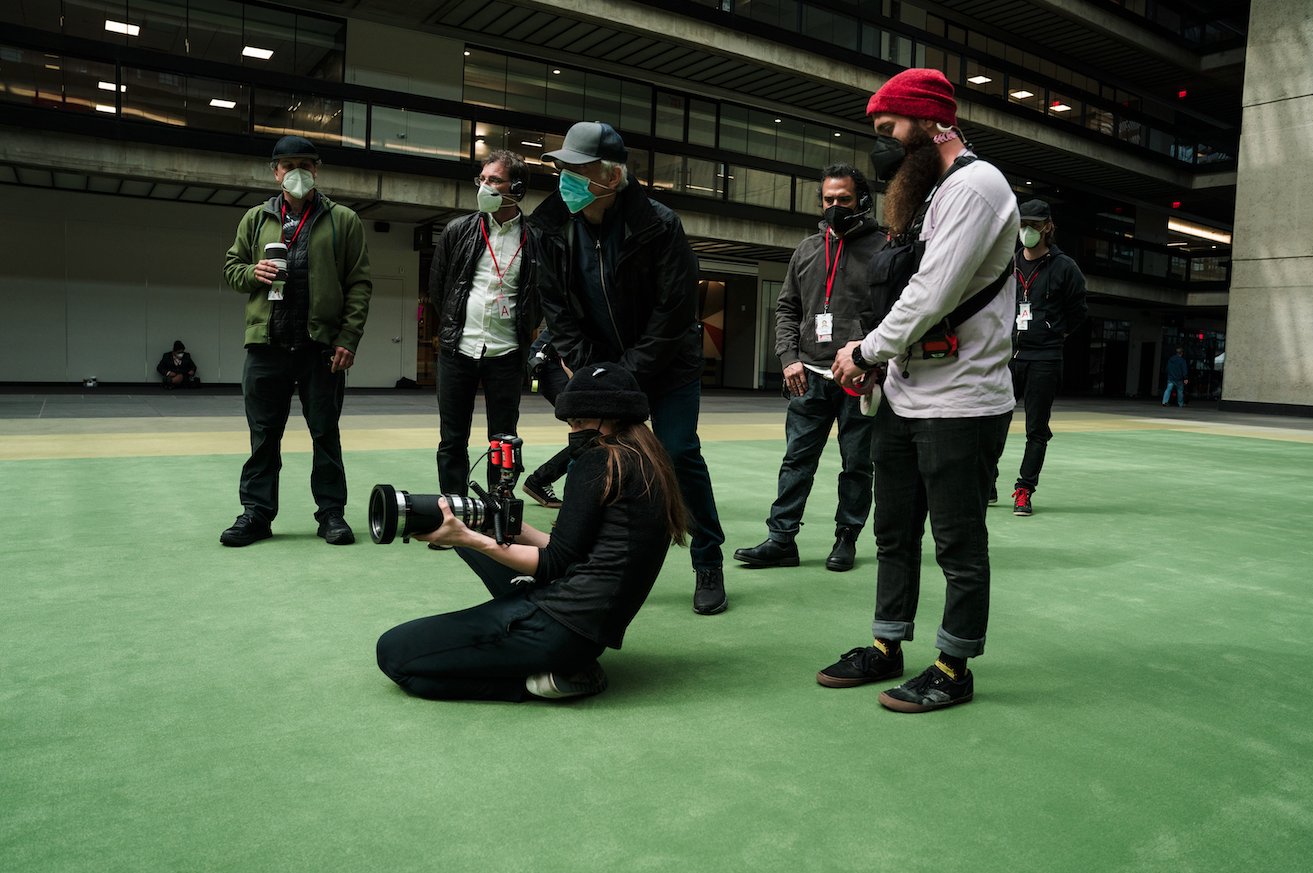
Credit: Courtesy of Apple
I know Ben has been a longtime fan of yours. How did you two start working together?
Well it really came out of nowhere — like out of nowhere. [Laughs] I’m someone who came from the indie film world, like more festival type movies — French Canadian, then European, and I did some work in India as well. I was kind of just following my gut, doing one project after the next, just working on the craft and trying to find the right partner for me. And at one point I was about to move to France. I wanted to get some new goals and live in Paris, because I love Paris. And I got this email the day I was leaving about working on Escape. And I was like, ‘What is this? Where did this come from?!’ I always felt that I would work in the US — like I knew that that was a goal of mine — but I didn’t think it was going to happen that soon. And then I got this email saying, ‘Hey, would you be interested in doing this project?’ And then we met on a Skype, and it went really well. And we went on this other meeting in person, and I think our visions kind of collided. We had the same favorite type of movies, and we were both really into New York 70s films. I think the way that I like to work really resonated with him. It was such an intuitive thing. It just happened.
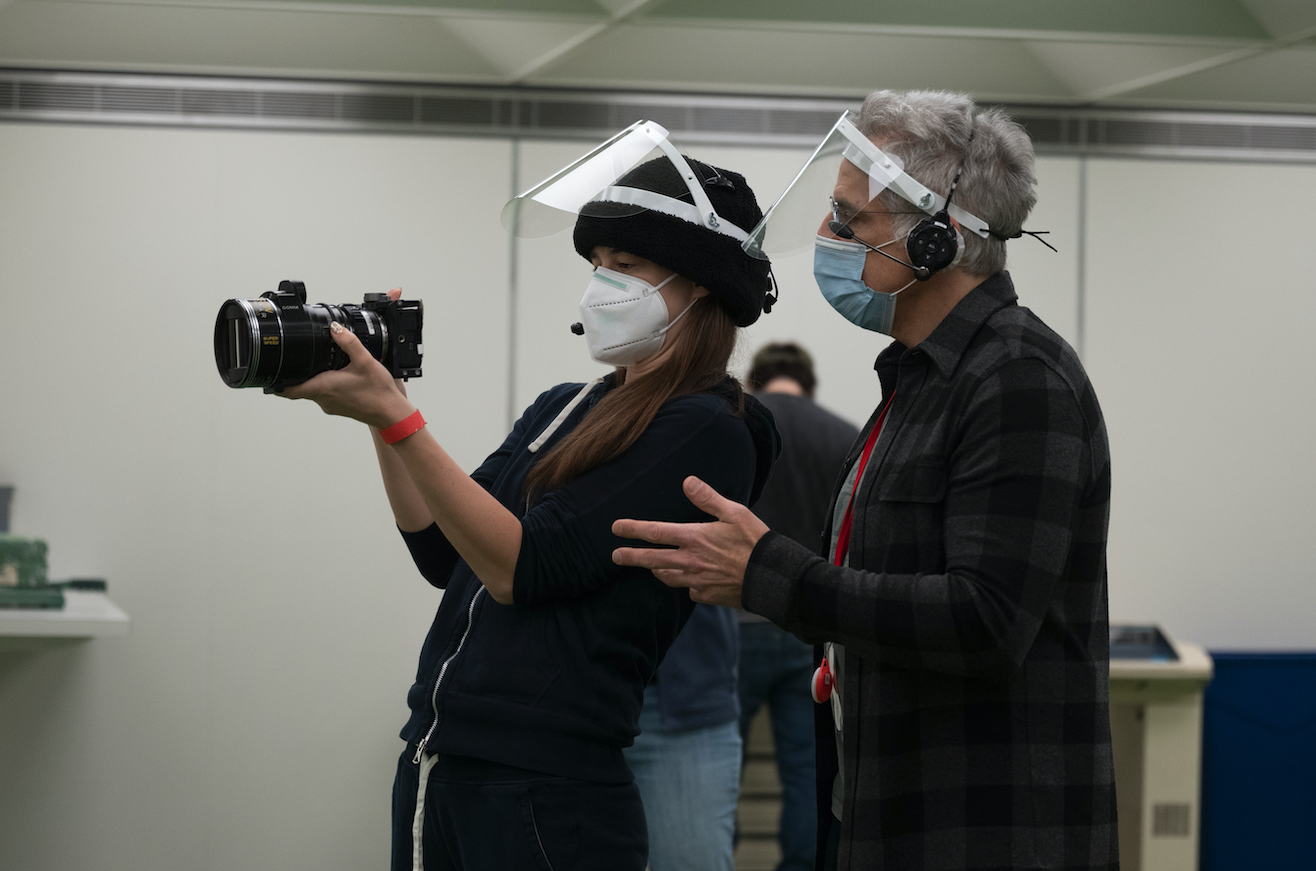
Credit: Courtesy of Apple
I love that you got the email on the day that you were leaving. Chaos. That’s always how the best stuff happens.
Yeah, when that happens you just think you have to go with the flow. You can’t resist it.
So, I know we love Ben. But what was it like working with such a stacked, phenomenal cast?
There’s an incredible balance and magic that happened in the casting. Props to Rachel Tenner. She truly is an amazing casting director and really finds — you have actors like Chris Walken, John Turturro, and Adam Scott — these powerhouse kind of actors, right? But she just mixes it up with unique people and it’s what you needed in that world. Even visually, they’re all extremely different, you know? Physically, you’re getting all these different shapes and sizes, and it works really well together. And working with them was amazing. There’s a lot of respect that needs to be given to them for how we went about this project. Sometimes you get lost in the process and you have to remember what they’re going through, and the schedule was extremely rough. They had to go from shooting one scene from one episode to another scene from another episode from the whole season together. They did that so seamlessly. I mean, Ben definitely was there guiding them, but to see them be able to follow their characters the way they did emotionally was really amazing.
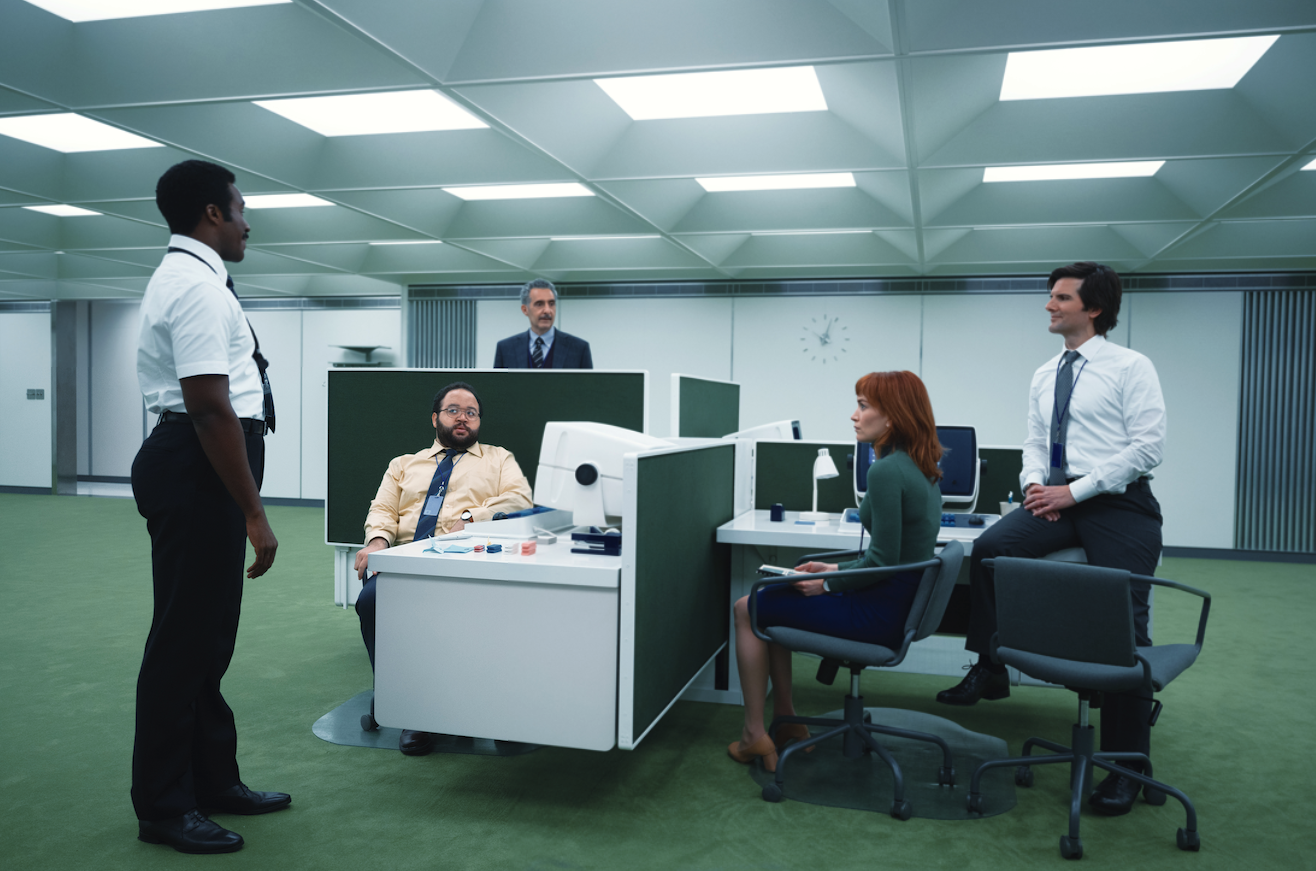
Credit: APPLE TV+
I can’t imagine how challenging it was just to switch between the Innie and Outie worlds. And it really is such a serious, emotionally demanding show. That said — I’m not ready for it yet, but one day I would love to see a Severance blooper reel of everyone breaking in this very strict office.
Well the office, it’s very interesting to think about, because the set never changes. It’s just so…that’s it. You know? [Laughs] And they have nothing to go off of. They’re literally going into the office every day with like a blank slate and there’s nothing to tweak. There’s no sun coming through a window for them to be moody with or whatever.
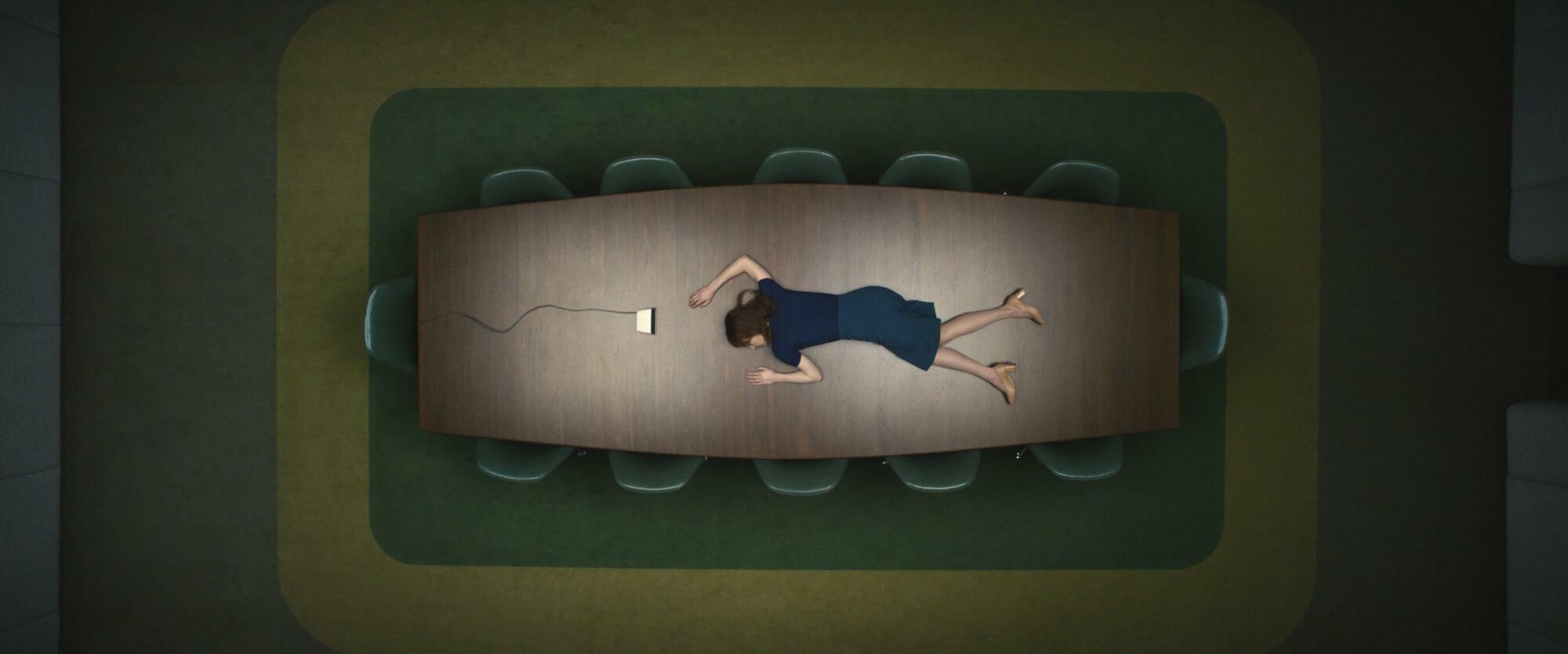
Credit: APPLE TV+
Definitely. I know the set was largely unchanging, but the unique camera placement and movement and angles present in all nine episodes really help the setting feel fresh. We see it right from the opening shot; that aerial view of Helly on the conference table. What inspired those bold aesthetic choices?
I can speak to that shot in particular. I believe that the production designer and Dan [Erickson, Severance creator] had been thinking about this. And Ben always wanted that top shot. But I think for Dan, that conference room was kind of like the birthing room. It’s the room that they’re born into, right? In this world, it’s where they wake up. So I wanted it to have a womb-like feeling, and that’s a bit of what that shot was bringing. But more generally for the show we knew we wanted two aesthetics. We knew we wanted an outside world and an inside world. That was very obvious. But we didn’t want them to not feel like the same show, because we could have done the approach where we’d get two sets of lenses and light super differently. But ultimately what we did was use different lenses in the same kit. You have wider lenses, which would force us to go closer, for the inside world. So we were closely monitoring the actors. And then the outside world was a lot more longer lensing, so we were further away from a distance. There’s that very certain aesthetic in the outside world, just maybe a little more 70s old school. And then the interior world is like robotic, weird, feels mechanical. It’s a lot of security camera footage.
Oh yes, I’m obsessed with all the security footage in the series.
Yeah, they’re like animals in the zoo. You know? And they’re being watched. Some of the footage looks almost like those cameras that they put out in nature to kind of like capture people.
A nice live stream.
Yeah, yeah, yeah. [Laughs]
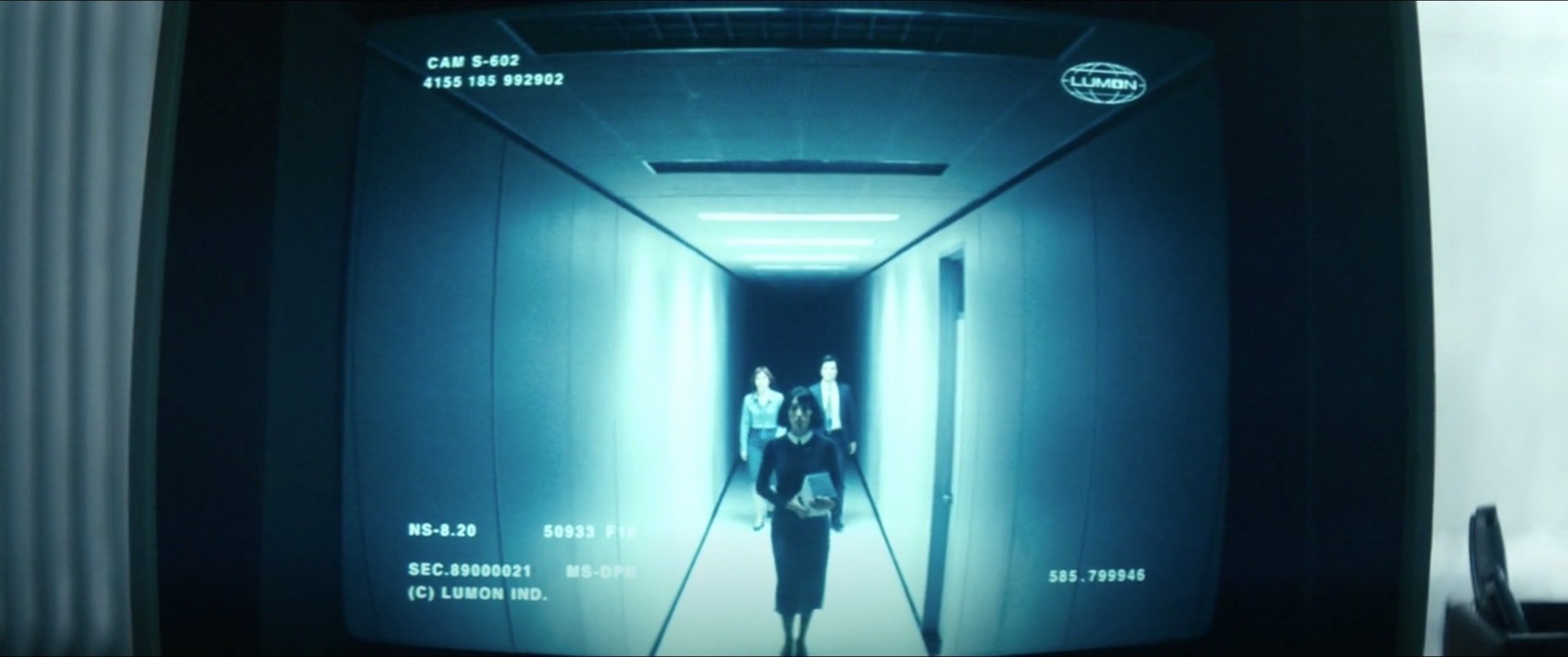
Credit: SCREENSHOT: SEVERANCE / APPLE TV+
I heard something on a podcast you did that I haven’t stopped thinking about. It’s maybe not a big deal to anyone else, but I’m obsessed with this one little comment you made about having a mood board in the hallways before each episode. Could you tell me a bit more about that and how it informed your work for the day?
I mean, mood boards have always been a thing for me. Every project I’ve done for years and years now I’ve always done mood boards. I visualize the movie like that. Ben really liked them. He really encourages the process. So when we did it on Severance, I’m always like, “We need an office with a lot of white walls.” And props and design takes over every freaking thing, and I love them, but I also want my white walls. So they gave me the hallway. They’re like, “You can use the hallway.”
Oh there were certainly enough hallways in Lumon.
Well, it was in the stage’s hallways, between my office and Ben’s office. And then all the actor’s dressing rooms were in between that. And props was close. But anyone who walked through that hallway could see what the show would look like. That was the show. So I made every scene a mini section. This was a really huge mood board. It was huge.
I’ve seen entire episodes broken down scene by scene on Twitter and they’re giant, so I’m sure the board was massive.
Well, the [show] images weren’t created yet. But the mood board had like rough visuals, which could have been paintings, photo stills from other movies, our storyboards were all there. Like we’re not trying to hide anything. It’s all there so that everyone could see what the show was going to be. Set designs were there. Like if Jeremy Hindle [Severance‘s production designer] made 3D renderings I would put them there and post the lineup next to it or whatever. And I’d often catch people stopping and looking — just staring.
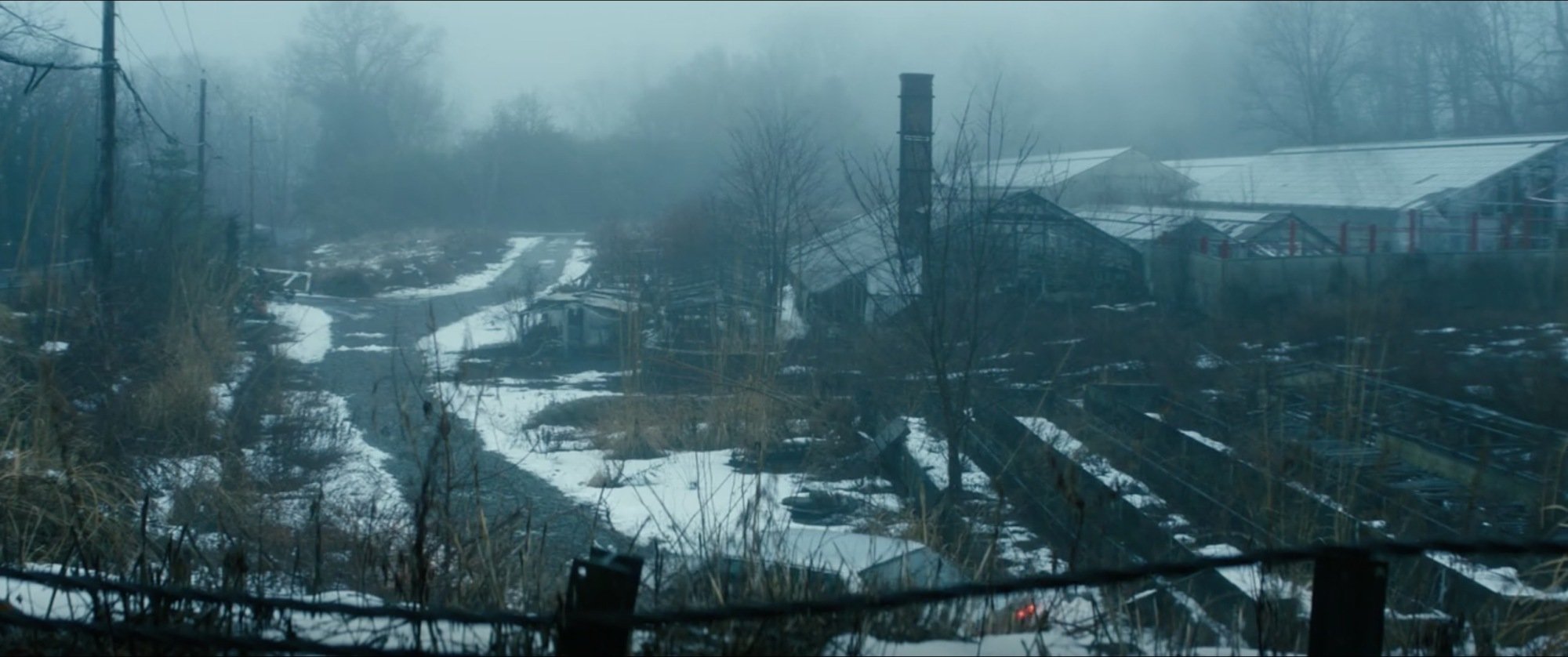
Credit: SCREENSHOT: SEVERANCE / APPLE TV+
Oh my gosh, that’s awesome.
Like the episode where Mark goes to the greenhouse, it was gonna be foggy. That was always the foggy episode, and I was like, “How are we gonna do that? I don’t know. I’m not really into it. I don’t know how to deal with it.” So when we were going to shoot the greenhouse it was the one moving thing on the schedule. And I’m like, “It just needs to go on a rainy day.” And it ended up being the [foggiest day]. We were trying to keep it on a Monday so it could be an early shoot and they could do it blue hour if it wasn’t raining. And I noticed it was gonna rain on that day. And I’m like, “Can we do an extremely early call?” It’s something we didn’t want to do in general because it’s really hard on the crew. But that day we had a 4 a.m. crew call. I mean, I felt horrible. And we really try not to do that often. But it was the foggiest day of the year! It just happened! And we wanted it to look like Red Desert. So on the mood board there’s like these images of Red Desert, a Michelangelo Antonioni film that has this crazy fog. It was a process.
OK, I love that. I’m not sure if you know of the popular Twitter, @OnePerfectShot, but it shares particularly stunning shots from TV series and movies. And the perfect shot they pulled from Severance was that iconic moment where Burt and Irving almost kiss in the plant room. Could you talk a bit about the approach to that scene? Because it was so beautiful and really resonated with fans.
That scene was shot with Aoife McArdle, the other director. She’s in the middle episodes. It was an interesting one. I think being in a room with all those fake plants was just weird from the beginning. And then there’s like mirrors at the back of the room. So it was really hard to kind of not see ourselves. But it was really magical. I think we had several different wide shots for that scene, and they were all amazing. I don’t know how they just chose what worked the best. It was probably the more intimate work that ended up standing out. But it was a very traditional shooting process. We had a rehearsal. Aoife had ideas that she wanted to try and accomplish, and then [Turturro and Walken] just went into it. And they just gave a lot of space for the operators to try and find stuff as well. It was driven by a little bit of everyone I think.
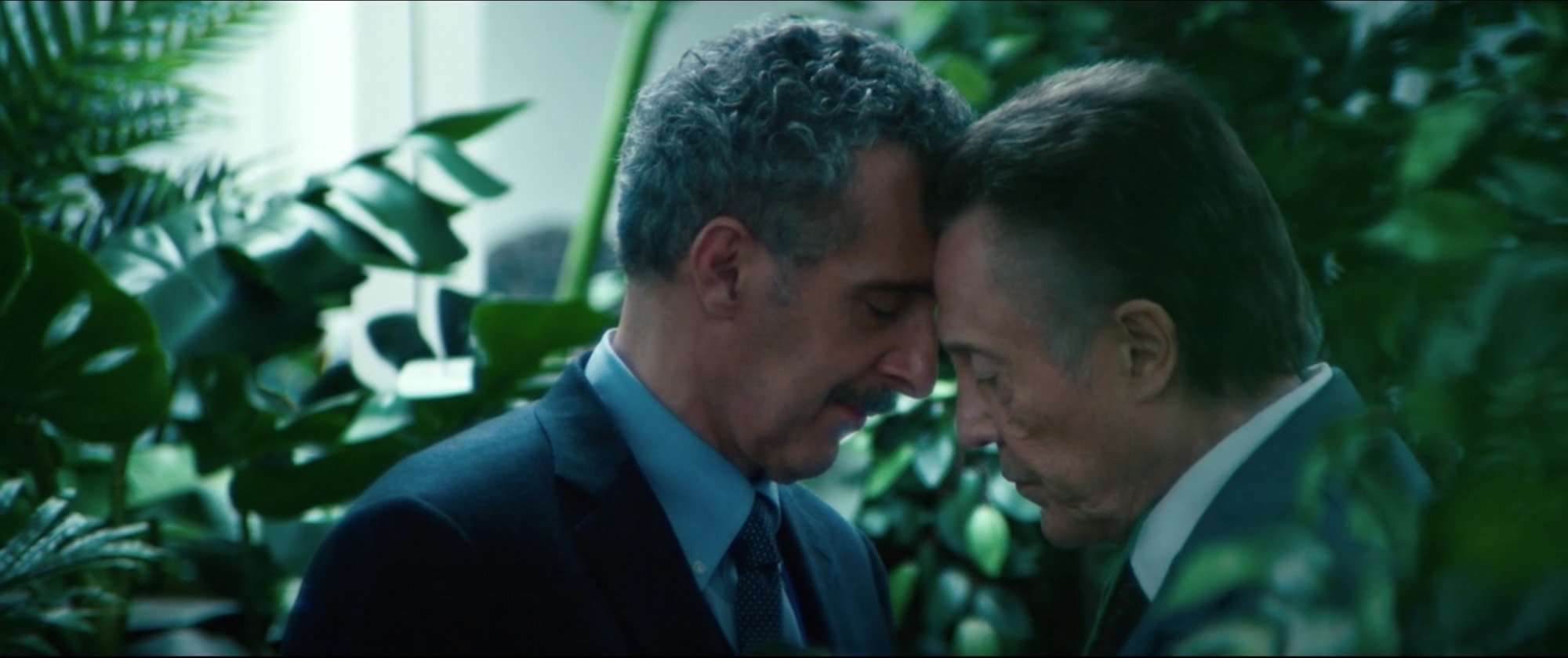
Credit: SCREENSHOT: SEVERANCE / APPLE TV+
Every shot in this series is remarkable. But I have such a special place in my heart for the moment where we see Mark and Helly in the kitchen. They’re about to flirt over their deviled eggs. And the camera captures them reflected in a mirror on the wall, and the room is like doused in pink light. It blows me away every time. I know it’s probably impossible for you to choose just one, but do you have a favorite shot or something you were able to capture on camera that especially moved you?
It’s weird that you mention that shot because I think it might be one of the moments that I did say, “This is my favorite shot.” It was a frame I actually took on Artemis, and I was like, “Ben I’m gonna do this shot. Like, it’s our Wong Kar-wai scene.” For me, the pink was also something I need to convince him on. [Laughs]
Oh my gosh, what?! It’s so good.
He didn’t want to do pink, and I’m like, “We need this. This is gonna be so good. It’s our love scene. It’s like the only moment where they’re connecting like that. And he supports it after that. But yeah, it was a magical moment but that was like very Wong Kar-wai inspired.
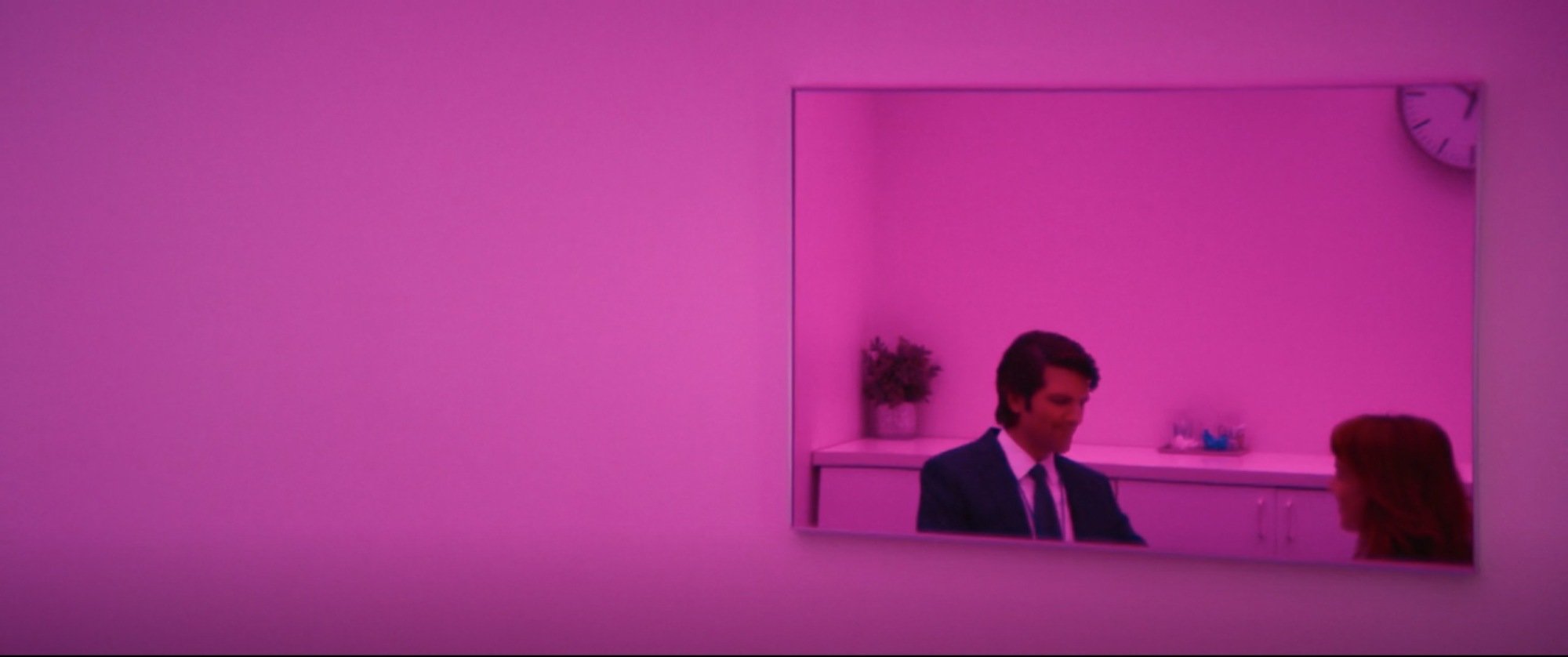
Credit: SCREENSHOT: SEVERANCE / APPLE TV+
I love it. I’m so glad that he listened to you. Great job, Jessica. And great job Ben for listening to Jessica, and of course, directing. [Laughs] I know that you were initially reluctant to work on Severance because you were worried about the lighting on set. Could you share a bit more about that?
I think reading the premise at first I was scared of it. Ben was very enthusiastic, and I mean little did I know he was so right about this project. You know, he saw something in the humanity of it, I think, that he really connected with. As a cinematographer, I’m reading the project from a little bit of a different point of view, and I was more feeling really stuck and not able to kind of do the things that I love to do, which is, like, light a scene and make it have a mood and feeling. And I felt like I was going to be really trapped.
I think it could have easily been a fluorescent white light situation every single time those characters went down the elevator. But you really made the most of lighting as a source of color in the show and also used a lack of light to strike certain moods, which was wonderful.
There was a lot of openness in terms of making the lighting different. Working with the production designer, having a lot of input on the ceilings, and like bringing little details to scenes where I knew that I wanted them — like to have a practical on their desks. That was a bit of a fight, because they were like, “Oh yeah, it’s cooler to have nothing and for it to be really bare.” And I’m like, “I know. But there’s gonna be a scene where we’re gonna use it, and I really want it.” And I fought for it, and one of my favorite scenes is where Adam is taking out the map from that photo frame. It’s just so great for that scene, because that sets the tone, and you really feel the creepiness. It would have felt completely different in white light. And every time there’s like darkness in the underground world it means something — there’s like a revelation. There’s some unknown there. So it was really fun to play with that. And Dan and Ben are super open to those kinds of ideas, and then they also start getting ideas as well.
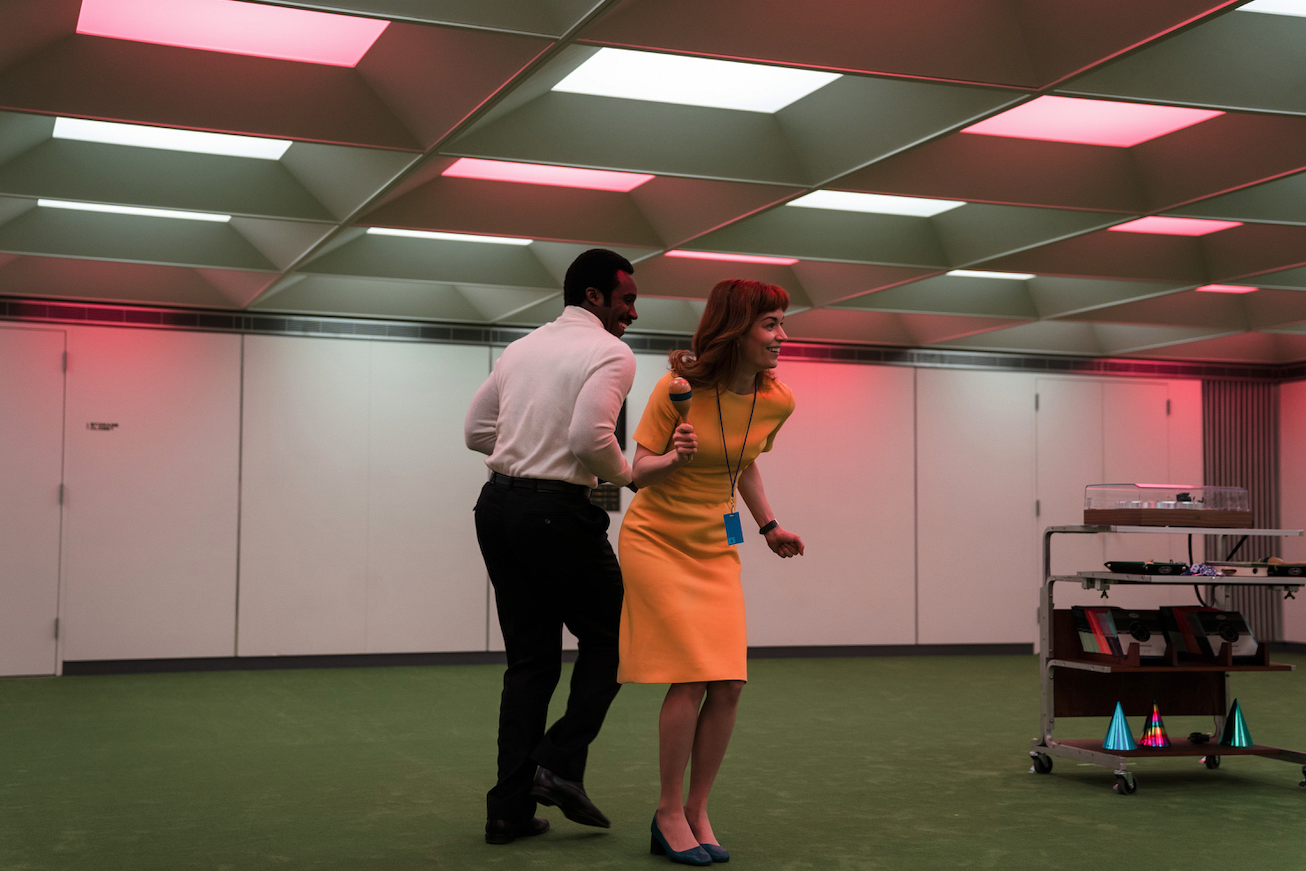
Credit: APPLE TV+
I think the collaborative process that Severance was really allowed for things to flourish. That fear of doing the same thing all the time really pushed me personally to find those details and make it special. Like, when the MDE happens you’ve been in this world for a long time. There’s no color, there’s nothing. And it just blows your mind. You’re like, “What is going on?” And for the people on set it was the same thing. When we were working on the lighting design we would do tests and look at it, and people would walk by and just be in awe. Like, “What? This is happening? I’ve never seen the set like that.” It was really magical.
